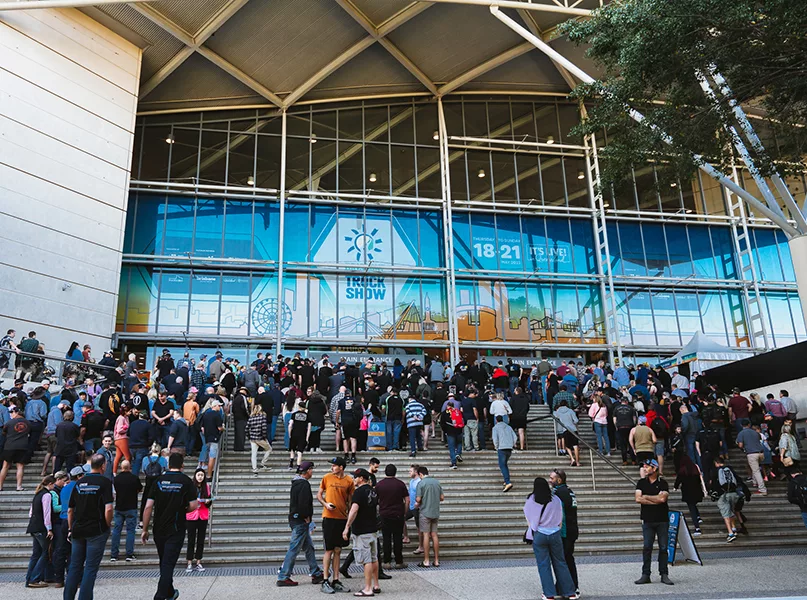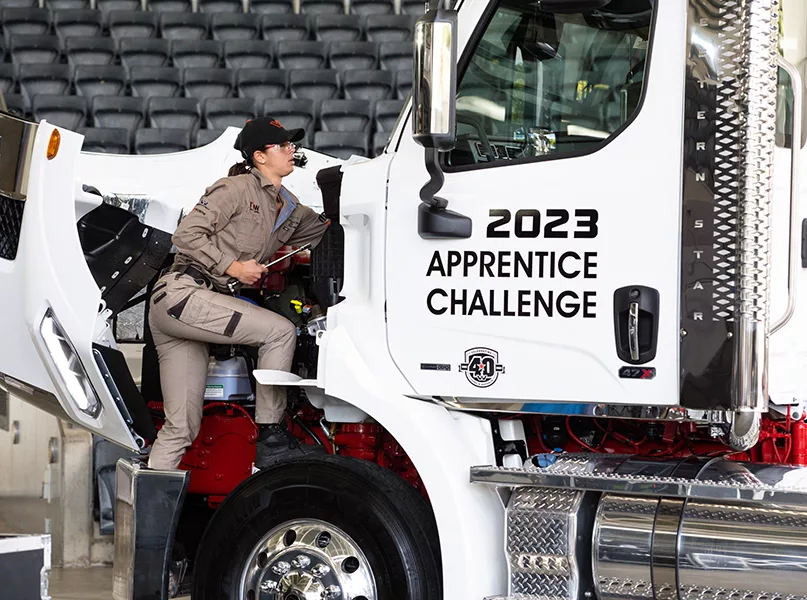Q&A WITH TODD HACKING, CEO, HEAVY VEHICLE INDUSTRY AUSTRALIA
Todd Hacking, CEO of Heavy Vehicle Industry Australia (HVIA), discusses representing and advancing the interests of manufacturers and suppliers of heavy vehicles and their components, equipment, and technology.
Membership of HVIA includes almost every major truck manufacturer and importer, most of Australia’s major trailer manufacturers, and an ever-growing list of their suppliers and distributors.
HVIA’s 300+ members reap the rewards through low-cost membership, opportunities to engage and contribute to industry policy development, and regular networking events and information forums across the country.
Members also benefit from advocacy to government and its regulatory agencies on national, regional, and local issues, technical and regulatory support, and world-class national events including the Brisbane Truck Show.
Committed to providing leading advice and assistance, whilst directing and influencing policy at all levels of government, HVIA delivers the best possible outcomes for members, the wider industry, and the community.
Firstly, could you talk us through the origins, mission, and vision of HVIA?
Todd Hacking, CEO (TH): HVIA – then known as the Commercial Vehicle Industry Association of Queensland (CVIAQ) – began life in Queensland in 1968, initially to operate the Brisbane Truck Show, which was first held at Haulmark Trailers’ headquarters in Rocklea, Brisbane, featuring 21 transport industry exhibitors.
It was subsequently incorporated as a company in 1970 to represent and provide services for the Queensland heavy vehicle sector.
In 2015, CVIAQ became HVIA, with a purpose to represent and advance the interests of the nation’s entire heavy vehicle industry.
HVIA’s mission is to advocate for a successful and sustainable heavy vehicle industry with a strong, unified voice, while its vision is to promote an innovative and prosperous heavy vehicle industry, supporting the safest and most productive fleet.
“HVIA’s mission is to advocate for a successful and sustainable heavy vehicle industry with a strong, unified voice”
Todd Hacking, CEO, Heavy Vehicle Industry Australia

To deliver on its mission and vision, the member-based organisation focuses on four key work programmes:
Advocacy: HVIA is committed to providing leading advice and assistance to its members and directing and influencing policy at all levels of government with a commitment to delivering the best possible outcomes for its members, the wider industry, and the community.
Member services: HVIA’s cost-effective membership includes a range of services, including:
- TechAssist – Technical and regulatory support.
- EmployerAssist – HR fact sheets, updates, and an industrial relations (IR) hotline.
- Jobs Hub – Promoting the industry’s diverse career paths.
- Training and education – Regular online and practical face-to-face courses.
Workforce developments: HVIA is committed to promoting the development of the industry through securing a highly skilled workforce to ensure viability and capacity to deliver innovation.
It does this through a variety of initiatives aimed at addressing the quality and relevance of apprenticeships and traineeships, delivery standards, and career promotion, including the National Apprentice Challenge, the National Apprentice of the Year Awards, and Schools to Industry Tours.
HVIA continues to promote careers in the industry through its highly successful Schools to Industry Tours, which are organised in conjunction with an ever-increasing network of secondary schools.
The tours provide students with a means to explore all the potential career options within the heavy vehicle industry and enable them to make informed decisions about their future careers.
National events: HVIA stages a number of world-class national events to provide a platform for its members and customers to come together, share ideas, discuss challenges, and showcase innovative ways to tackle them. These include:
• The Brisbane Truck Show – The southern hemisphere’s largest road transport event.
• TruckShowX – Australia’s largest road transport decarbonisation event.
• HVIA National Awards – An annual gala dinner that presents a suite of leadership and innovation awards, acknowledging and celebrating the Australian heavy vehicle industry’s capacity to provide cutting-edge solutions for the road transport task.
• HVIA Executive Club – An exclusive quarterly event designed for industry leaders to convene on a regular basis to share knowledge and discuss common issues with their peers across the heavy vehicle industry.
• HVIA Member Forums – A regular interactive forum to inform members on current and emerging issues and opportunities, tap into the views of our membership, and provide an opportunity for members to get together with their peers.
• HVIA Connect – A new casual peer-to-peer networking event aimed at creating connections in an informative way.
What is your current take on the industry, and what makes Australia a world leader in many aspects of heavy vehicle transport?
TH: Road transport plays a critically important role in the Australian economy. The freight and logistics sector represents an estimated 8.6 percent of Australia’s GDP and provides critical economy-wide linkages, especially for the construction, manufacturing, mining, hospitality, retail, and wholesale sectors.
The industry directly employs 70,000+ people and its fleet of approximately 600,000 registered trucks (500,000 rigid and 100,000 articulated vehicles) travel an estimated 250 billion tonne kilometres (btkm) per year – a figure that is forecast to grow to circa 400 btkm by 2050.
The critical role road transport plays in moving goods across Australia’s vast distances has underpinned an incredibly dynamic and innovative approach to the task, with the country recognised as a world leader in the development of higher-productivity truck and trailer combinations that can transport more freight with fewer truck movements, resulting in reduced fuel consumption, lower emissions, and better safety.

What substantial challenges does the increasing pace of technological change present to the industry and regulators?
TH: Road transport is one of the most heavily regulated industries in Australia and operates within a very complex regulatory environment.
Additionally, there are major regulatory stakeholders at every level – state, federal, and local, each covering facets of transport operations such as access, weights and dimensions, licensing, safety, and other operational matters such as driving hours and speed.
In this environment, regulatory change does not keep pace with technology and innovation. This often leaves the industry unable to capitalise on opportunities to improve safety, productivity, and environmental outcomes.
The next-generation of low and zero-emissions heavy vehicles are a good example – some may not be able to be registered and operated in Australia without increases to steer and drive axle mass limits.
Equally, how significant is the focus on innovation and regulatory reform to support the performance of the Australian economy into the future?
TH: Without a doubt, the biggest regulatory issue facing the industry currently is the lack of a truly national regulatory framework. HVNL is not recognised by every state and territory, which creates unnecessary duplication amongst regulators, and complicates operations for industry, for no benefit at all.
Furthermore, amongst those states that do recognise HVNL, there is disagreement on basic matters such as vehicle and axle configuration, and maximum axle mass limits, which leads to inconsistencies across state borders.
These matters unnecessarily restrict progress, and act as roadblocks towards innovation.
The industry urgently needs nationally harmonised regulations that both encourage and foster improvements at all levels.
How does HVIA represent and advance the interests of manufacturers and suppliers of heavy vehicles and their components, equipment, and technology?
TH: HVIA represents and advances the interests of the entire industry involved in design, manufacture, importation, distribution, modification, certification, sale, service, and repair of on-road vehicles with gross vehicle mass or aggregate trailer mass over 3.5 t and their components, equipment, and technology.
Our members include every truck OEM, 49 of the top 50 trailer manufacturers, and every major component supplier, as well as heavy vehicle dealers, technology, equipment and component suppliers, segments of the repair and maintenance industry, and the engineers and consultants that support each of the above businesses.
HVIA seeks to promote an innovative and prosperous industry that supports a safe and productive heavy vehicle fleet operating for the benefit of all Australians by:
- Holding major industry events including Brisbane Truck Show, Australian Heavy Vehicle Industry Week, South Bank Truck Festival, and TruckShowX.
- Ensuring members are well-informed with a weekly newsletter (4,500+ subscribers) and quarterly ROADBOSS magazine (distribution of 12,000+).
- Recognising industry excellence through our annual awards night, including Apprentice of the Year.
- Establishing working groups to address prominent issues.
- Collaborating with other peak industry bodies to ensure a unified voice.
- Understanding industry’s views through state committees, industry forums, and regular contact.
- Advocating to government on behalf of industry.
- Encouraging people to participate in the industry.
- Supporting mental health with Healthy Heads in Trucks and Sheds.
How committed is HVIA to providing leading advice and assistance to members, and directing and influencing policy at all levels of government?
TH: HVIA is extremely committed to both providing advice, assistance, and support to members, as well as directing and influencing government policy at all levels.
The heavy vehicle industry is extremely intertwined, and to some degree, over-regulated. As such, ensuring HVIA members’ voices are heard by the right decision makers at the right time is just as important as the content of what is being said.
HVIA already has an incredible reputation as an association that is well in-tune with the views of its members and can identify where it is lacking. We also have a rigorous and fair process for establishing a policy position, which is informed and based on strong, reliable evidence.
We say what we mean, and we mean what we say, whilst having the evidence to back it up – which often ensures that when we speak, we are not only heard but listened to.
This is an immensely powerful position, but it is one that cannot be taken for granted. You only get one reputation and what can take a lifetime to create can be ruined in a split second, so it is really important that HVIA’s legacy remains in place, and that the long-established systems and processes which has enabled the association to achieve a strong reputation are never compromised.

How do you see the heavy vehicle industry in Australia developing over the next five years?
TH: HVIA is in an enviable position, due to its 55-year history, stable and loyal membership, and being respected by government and regulators at all levels for providing measured, considered, informed, and accurate advice.
The next five years present amazing opportunities as the HVIA restructure takes shape and we invest further in the association’s resources and capabilities. As we do so, every single decision is run through the lens of “will this make the industry better?” or “will this create value for our members?”.
There is a huge and exciting journey of decarbonisation ahead which, whilst only just beginning in the commercial realm, is extremely busy in ensuring accurate advice off the back of informed analysis and evidence-based decisions are made in the interest of establishing the regulatory environment for investment.
This is not just a truck issue; there is an ecosystem of stakeholders – some of whom are transacting for the first time, and HVIA will play a role in ensuring the right environment exists to guarantee that the entire industry can thrive. This must be done in a considered and respectful way to ensure the association does not tread into the commercial sphere, which rightly belongs to the individual members and their suppliers.
HVIA will also need to be at the forefront of how this impacts issues like safety and skills development, which we have a goal to lead. Our vision is for a standalone automotive skills academy to grow a pipeline of the next-generation workforce.
HVIA has also long held the belief that the transport association landscape is cluttered and confusing, and that rationalisation would certainly simplify and improve industry outcomes. HVIA is keen to ensure that we are speaking with one unified voice or acting as collaboratively as possible so that the heavy vehicle supply chain (downstream) and the freight task (upstream) are as safe and efficient as possible.
“The next five years presents amazing opportunities as the HVIA restructure takes shape and we invest further in the association’s resources and capabilities”
Todd Hacking, CEO, Heavy Vehicle Industry Australia
Finally, what are HVIA’s key priorities to continue representing and advancing the interests of manufacturers and suppliers?
TH: The industry faces considerable headwinds – most notably with projected growth in the freight task, ongoing global supply chain sensitivities, skills and labour shortages, inflationary pressures, and the need to decarbonise and transition to net zero.
The heavy vehicle industry is among the few remaining local manufacturing industries. A diversity of skills – as well as government support to facilitate innovation – are needed for the sector to thrive.
Our members are always innovating and improving the safety of their fleets and require flexible and responsive regulations to allow that innovation.
We support the transition to net zero, but seek government assistance in building the value proposition, creating infrastructure, solving access issues, and researching the applicability of different propulsion technologies for various purposes.
We see a leadership role for federal government to harmonise the states, territories, and local government’s regulatory approaches, operating standards, and decarbonisation efforts.

In this regard, HVIA seeks the following:
Manufacturing sovereignty
- Support via financial and tax incentives.
- Support for advanced manufacturing.
Skills and training
- Modernisation of VET and improved flexibility of the training system.
- Data-backed reports to understand current and future people/skills needs.
- Incentives for people to train in positions with identified shortages.
Higher productivity and efficiency
- Investment in infrastructure, such as battery charging or alternative refuelling stations.
- Cutting wait times for obtaining vehicle access route approval.
- Investment in road networks to improve access for higher-productivity vehicles.
Policy and regulation
- Leadership from the federal government on state/territory regulatory harmonisation and a heavy vehicle net zero roadmap.
- Net zero transition assistance, such as tax incentives, R&D, trials, grants to invest in net zero vehicles, and priority Performance Based Standards (PBS) approval.
- Removal of barriers for uptake of high-productivity vehicles, such as mass limits.
Facilitating innovation
- Cutting red tape to reduce time to market for new vehicles.
- Streamlining importing procedures.
- Support for local manufacturing to take up new technologies.
AUSTRALIAN HEAVY VEHICLE INDUSTRY PARTNERS















































